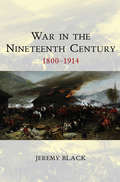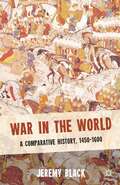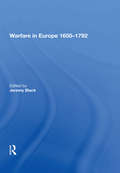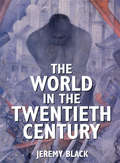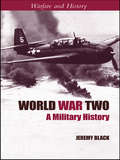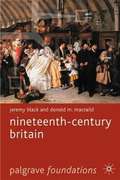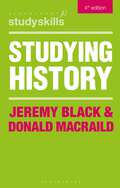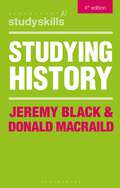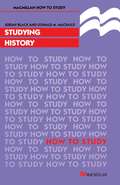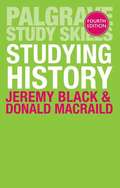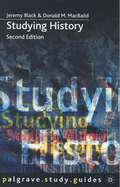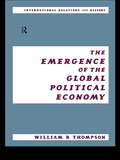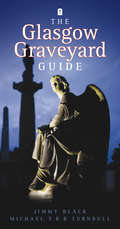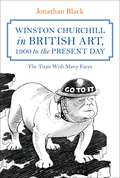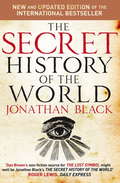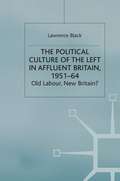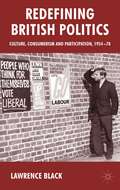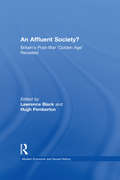- Table View
- List View
War in the Nineteenth Century: 1800-1914 (War and Conflict Through the Ages #2)
by Jeremy BlackThis book provides an accessible and up-to-date account of the rich military history of the nineteenth century. It takes a fresh approach, making novel links with conflict and coercion, and moving away from teleological emphases. Naval developments and warfare are included, as are social and cultural dimensions of military activity. Leading military historian Jeremy Black offers the reader a twenty-first century approach to this period, particularly through his focus on the dynamic drive provided by different forms of military goals, or "tasking". This allows echoes with modern warfare to come to the fore and provides a fuller understanding of a period sometimes considered solely as background to the total war of 1914-45. Alongside state-to-state warfare and the move toward "total war", Black's emphasis on different military goals gives due weight to trans-oceanic conflict at the expense of non-Europeans. Irregular, internal and asymmetric war are all considered, ranging from local insurgencies to imperial expeditions, and provide a deliberate shift from Western-centricity. At the very cutting edge of its field, this book is a must read for all students and scholars of military history and its related disciplines.
War in the Nineteenth Century: 1800-1914 (War and Conflict Through the Ages)
by Jeremy BlackThis book provides an accessible and up-to-date account of the rich military history of the nineteenth century. It takes a fresh approach, making novel links with conflict and coercion, and moving away from teleological emphases. Naval developments and warfare are included, as are social and cultural dimensions of military activity. Leading military historian Jeremy Black offers the reader a twenty-first century approach to this period, particularly through his focus on the dynamic drive provided by different forms of military goals, or "tasking". This allows echoes with modern warfare to come to the fore and provides a fuller understanding of a period sometimes considered solely as background to the total war of 1914-45. Alongside state-to-state warfare and the move toward "total war", Black's emphasis on different military goals gives due weight to trans-oceanic conflict at the expense of non-Europeans. Irregular, internal and asymmetric war are all considered, ranging from local insurgencies to imperial expeditions, and provide a deliberate shift from Western-centricity. At the very cutting edge of its field, this book is a must read for all students and scholars of military history and its related disciplines.
War in the World: A Comparative History, 1450-1600
by Jeremy BlackWar was a central theme in the world history of the late fifteenth and sixteenth centuries, with military capability and activity central to its states, societies, economies and cultures. War in the World 1450–1600 provides an account of warfare in the period, placing it in global context. It offers a corrective to a narrative that has emphasised European developments and obscured the history of non-European military systems and cultures of war. Highlighting conflict between non-Western powers, which constituted most of the conflict around the world, as well as giving due attention to warfare between Western and non-Western powers, Black emphasises the breadth and variety of military trajectories and connections. This comparative context also provides a framework for considering the idea of a European-based Military Revolution. A wide-ranging account of world military history in a period of substantial development, the book will be essential reading for those interested in global history and conflict. War in the World 1450–1600 is designed as a companion volume to Jeremy Black's Beyond the Military Revolution: Warfare in the Seventeenth-Century World.
Warfare in Europe 1650�792
by Jeremy BlackScholars have tended to underrate the importance of war in the period 1650-1792, as there is a feeling that periods before and after were more consequential for military development. This collection of essays sets out to address this problem, probing the nature of warfare throughout Europe from the middle of the seventeenth century to the end of the eighteenth.
Warfare in Europe 1650�792
by Jeremy BlackScholars have tended to underrate the importance of war in the period 1650-1792, as there is a feeling that periods before and after were more consequential for military development. This collection of essays sets out to address this problem, probing the nature of warfare throughout Europe from the middle of the seventeenth century to the end of the eighteenth.
The World in the Twentieth Century
by Jeremy BlackFrom this major author comes a totally unique history of the twentieth century. Eschewing the traditional model for histories of this kind – blow-by-blow political narratives typically overloaded with detail - Jeremy Black offers us instead a brilliant thematic account of the last 100 years with the environment and the continuing strength of religious belief at its centre. Looking back to the 1910s and 1920s, Black begins with "the greatest issue of all" – the natural environment and its destruction, and moves to show how our world been transformed by urbanisation and development. Amazing developments took place across the century: men walked on the moon, the internet revolutionised communications; advances in health and medicine; developments in manufacturing and technology; economic globalization – all have changed the way different parts of the world related to each other. How have these revolutionary changes impacted on religion and politics? In the final sections of the book, Black looks at the persistence and growing extremism in religious belief, how change creates instability and wars, and how power blocs emerged and collapsed in response to all these developments. This is twentieth century world history on a truly global scale. The Twentieth Century World forces us to rethink the way we view the past, and offers us a new way to understand the present.
The World in the Twentieth Century
by Jeremy BlackFrom this major author comes a totally unique history of the twentieth century. Eschewing the traditional model for histories of this kind – blow-by-blow political narratives typically overloaded with detail - Jeremy Black offers us instead a brilliant thematic account of the last 100 years with the environment and the continuing strength of religious belief at its centre. Looking back to the 1910s and 1920s, Black begins with "the greatest issue of all" – the natural environment and its destruction, and moves to show how our world been transformed by urbanisation and development. Amazing developments took place across the century: men walked on the moon, the internet revolutionised communications; advances in health and medicine; developments in manufacturing and technology; economic globalization – all have changed the way different parts of the world related to each other. How have these revolutionary changes impacted on religion and politics? In the final sections of the book, Black looks at the persistence and growing extremism in religious belief, how change creates instability and wars, and how power blocs emerged and collapsed in response to all these developments. This is twentieth century world history on a truly global scale. The Twentieth Century World forces us to rethink the way we view the past, and offers us a new way to understand the present.
World War Two: A Military History (Warfare and History)
by Jeremy BlackCutting through over half a century of historical build-up, this new and convincing account of World War II uses a global perspective to explain the complicated course in military terms. Black, a distinguished military historian , bucks the current trend to demilitarise and gives due weight to the campaigns and battles that made up the war. In doing so he challenges common interpretations and includes new insights to make this one of the most exciting new histories of the Second World War. Covering all the main areas of conflict, the chronological approach includes analysis of attacks at land, air and sea and a comparison of military resources. The focus is always operational, but social, cultural and political aspects are also included. Providing a crucial counterweight to previous histories, Jeremy Black's World War Two offers fresh insights into operations at the Eastern Front and during the war against Japan.
World War Two: A Military History (Warfare and History)
by Jeremy BlackCutting through over half a century of historical build-up, this new and convincing account of World War II uses a global perspective to explain the complicated course in military terms. Black, a distinguished military historian , bucks the current trend to demilitarise and gives due weight to the campaigns and battles that made up the war. In doing so he challenges common interpretations and includes new insights to make this one of the most exciting new histories of the Second World War. Covering all the main areas of conflict, the chronological approach includes analysis of attacks at land, air and sea and a comparison of military resources. The focus is always operational, but social, cultural and political aspects are also included. Providing a crucial counterweight to previous histories, Jeremy Black's World War Two offers fresh insights into operations at the Eastern Front and during the war against Japan.
Nineteenth-century Britain (palgrave Foundations) (PDF)
by Jeremy Black Donald M. MacRaidThe nineetenth century was a period of striking developments, and subject to a great pressure of change. This process of change is the primary focus of the book. Organised into a series of thematic chapters, Black and MacRaild's wide-ranging text offers the reader an analysis of numerous spheres of human history: politics, empire and warfare; economy, society and population; religion and culture. The book also offers considered treatment of Scotland, Wales and Ireland, with a truly British (as opposed to English) perspective maintained throughout. With numerous illustrations, helpful explanatory tables, boxes and textual inserts, as well as a list of further reading with each chapter, Ninteetenth Century Britain is an excellent introductory text book for students of this most vital period in British history.
Studying History: (un)friendly Fire (Macmillan Study Skills)
by Jeremy Black Donald MacRaildThis best-selling guide will help you get to grips with the larger themes and issues behind historical study, while also showing you how to formulate your own ideas in a clear, analytical style. Fully updated throughout, further advice on using web-based sources and avoiding plagiarism will equip you with the tools you need to succeed on your course.
Studying History (Macmillan Study Skills)
by Jeremy Black Donald MacRaildThis best-selling guide will help you get to grips with the larger themes and issues behind historical study, while also showing you how to formulate your own ideas in a clear, analytical style. Fully updated throughout, further advice on using web-based sources and avoiding plagiarism will equip you with the tools you need to succeed on your course.
Studying History (How to Study Literature)
by Jeremy Black Donald M. MacRaildStudying History, a major new book by two practising historians, offers students a clearly-presented and comprehensive overview of the dynamic field of historical enquiry. Divided into three parts, on historiography, methodology and study skills, this is the first book to ally discussion of the philosophy and practice of history with useful guidance on how to study the subject more effectively. Studying History is an ideal introduction for A-level and undergraduate history students, as it presents the most important and up-to-date material in an accessible and practical way.
Studying History (Palgrave Study Skills Ser.)
by Jeremy Black Donald M. MacRaildThis best-selling guide will help you get to grips with the larger themes and issues behind historical study, while also showing you how to formulate your own ideas in a clear, analytical style. Fully updated throughout, further advice on using web-based sources and avoiding plagiarism will equip you with the tools you need to succeed on your course.
Studying History (PDF)
by Jeremy Black Donald M. MacraildThis revised and updated edition is written to convey a sense of history's many levels, from the broadest question what is history? to the everyday problems associated with studying the discipline. It provides both practical tips on how to write about history and guidance on how to get to grips with history's larger themes and issues.
The Emergence of the Global Political Economy
by Jeremy Black William ThompsonThe Emergence of the Global Political Economy challenges the assumption that the international political economy is a recent phenomenon. Instead this volume asserts that the current global political economy began to take shape around 1500 and that some of today's key processes were already perceivable several hundred years ago.The book explains the interdependence between long-term economic growth, global political leadership and global war and how this interdependence has evolved over the last 500 years, and includes discussion of:*the ascendence of Western Europe and the significance of the 1490s *the military superiority thesis*sequences of leadership and of challenge to the global political economy*the importance of commodities from sugar and cloth to slaves and bullion*the Anglo-American rivalry until the First World War.
The Glasgow Graveyard Guide (Graveyard Guide Ser.)
by Jimmy BlackIn Glasgow, death is always fatal. Students of glasgowness agree that there's a distinctive Glasgow 'take' on mortality. The visitor making the journey through the graveyards of Glasgow will surely become aware of a special Glaswegian condition -- apart, that is, from the common condition of death. You feel it when you start to absorb the atmosphere of the city -- its elements of the sad, the arrogant, the courageous, the righteous, the hilarious and the hideous, blended in strange proportions, all to be assimilated and enjoyed along with the weird and wonderful stories of the occupants of those quiet places of timeless repose. The journey can be a heady experience. It starts with the resting-place of Mungo's bones, then passes on to surgeon extraordinaire Maister Peter Lowe, to John Henry Alexander, the actor-manager credited with inventing the Great Gun Trick in which the trickster seems to catch a bullet in his mouth; past the grave of Pierre emile L'Angelier (allegedly poisoned by Madeleine Smith) and beyond to the headstone of Benny Lynch, World Flyweight Boxing Champion. The choice of graveyards in this book will hopefully catch the fancy and stir the imagination. Glasgow writer, the late Jimmy Black conducts this unusual tour of Glasgow's historic graveyards. The journey is a heady experience, taking you round the Cathedral, the Necropolis, St David's (Ramshorn); Sighthill, the Southern Necropolis; Calton, Jocelyn Square; the Western Necropolis; St Peter's (Dalbeth); St Kentigern's and Cathcart (today in East Renfrewshire). Just enjoy the fresh air and expect the unexpected.
A Short History of Transport in Japan from Ancient Times to the Present
by John Andrew BlackA Short History of Transport in Japan from Ancient Times to the Present is a unique study: the first by a Western scholar to place the long-term development of Japanese infrastructure alongside an analysis of its evolving political economy. Drawing from New Institutional Economics, Black offers an historically informed critique of contemporary planning using the example of Japan’s historical institutions, their particular biases, and the power they have exerted over national and local transport, to identify how reformed institutional arrangements might develop more sustainable and equitable transport services. With chapters addressing each major form of transport, Black examines the predominant role of institutions and individuals – from seventeenth-century shoguns to post-war planners – in transforming Japan’s maritime infrastructure, its roads and waterways, and its adoption of rail and air transport. Using a multidisciplinary, comparative, and chronological approach, the book consults a range of technical, cultural, and political sources to tease out these interactions between society and technology. This spirited new contribution to transport studies will attract readers interested in institutional power, the history of transport, and the development of future infrastructure, as well as those with a general interest in Japan.
Winston Churchill in British Art, 1900 to the Present Day: The Titan With Many Faces
by Jonathan BlackChurchill is today remembered as a great leader, a war hero, a literary heavyweight and a renowned wit. This incarnation of Churchill is the latest in a long-evolving identity, which at various times has sustained his power, enhanced his popularity and enabled him to personify aspects of British national identity.Indeed Churchill was more aware than most of the performative power of his public life. He lived in an age of the illustrated mass-produced newspaper, with its cartoons and 'Kodak-snappers'. He was well-known for his readiness to appear in uniform for photo opportunities during the Second World War and he not only wrote about the art of political caricature, but collected cartoons of himself, his allies and opponents.In this heavily-illustrated book, Jonathan Black considers the changing image of Churchill in visual art, from cartoons and paintings to photographs and sculptures. He asks how and why his image developed right up to the present day and examines the extent to which Churchill was complicit in its production.
Winston Churchill in British Art, 1900 to the Present Day: The Titan With Many Faces
by Jonathan BlackChurchill is today remembered as a great leader, a war hero, a literary heavyweight and a renowned wit. This incarnation of Churchill is the latest in a long-evolving identity, which at various times has sustained his power, enhanced his popularity and enabled him to personify aspects of British national identity.Indeed Churchill was more aware than most of the performative power of his public life. He lived in an age of the illustrated mass-produced newspaper, with its cartoons and 'Kodak-snappers'. He was well-known for his readiness to appear in uniform for photo opportunities during the Second World War and he not only wrote about the art of political caricature, but collected cartoons of himself, his allies and opponents.In this heavily-illustrated book, Jonathan Black considers the changing image of Churchill in visual art, from cartoons and paintings to photographs and sculptures. He asks how and why his image developed right up to the present day and examines the extent to which Churchill was complicit in its production.
The Secret History of the World: As Laid Down By The Secret Societies
by Jonathan Black Quercus QuercusTHE INTERNATIONAL BESTSELLERThe complete history of the world, from the beginning of time to the present day, based on the beliefs and writings of the secret societies.Jonathan Black examines the end of the world and the coming of the Antichrist - or is he already here? How will he make himself known and what will become of the world when he does? - and the end of Time. Having studied theology and learnt from initiates of all the great secret societies of the world, Jonathan Black has learned that it is possible to reach an altered state of consciousness in which we can see things about the way the world works that hidden from our everyday commonsensical consciousness. This history shows that by using secret techniques, people such as Leonardo da Vinci, Isaac Newton and George Washington have worked themselves into this altered state - and been able to access supernatural levels of intelligence. This book will leave you questioning every aspect of your life and spotting hidden messages in the very fabric of society and life itself. It will open your mind to a new way of living and leave you questioning everything you have been taught - and everything you've taught your children.
The Political Culture of the Left in Affluent Britain, 19 51-64: The Political Culture of the Left in 'Affluent' Britain, 1951-64 (Contemporary History in Context)
by L. BlackExploring relationships between politics, the people and social change, this book assesses the fortunes mainly of Labour, but also of the Communist Party and the New Left in postwar Britain. Using concepts like political culture, it looks at the left's articulation of 'affluence': consumerism, youth culture, America, TV, advertising and its disappointment at the people under the impact of such changes. It also examines party organization, socialist thinking and the use of new communication techniques like TV, advertising and opinion polling.
Redefining British Politics: Culture, Consumerism and Participation, 1954–70
by L. BlackA history of 1950s and 1960s British political culture, Redefining British Politics interrogates ideas, movements and identities bordering social and political change: consumer organisations; campaigns about TV, morality and culture; Young Conservatism; and how party politics used media like TV and was represented in popular culture.
An Affluent Society?: Britain's Post-War 'Golden Age' Revisited (Modern Economic and Social History)
by Lawrence Black Hugh PembertonDuring an election speech in 1957 the Prime Minister, Harold Macmillan, famously remarked that 'most of our people have never had it so good'. Although taken out of context, this phrase soon came to epitomize the sense of increased affluence and social progress that was prevalent in Britain during the 1950s and 1960s. Yet, despite the recognition that Britain had moved away from an era of rationing and scarcity, to a new age of choice and plenty, there was simultaneously a parallel feeling that the nation was in decline and being economically outstripped by its international competitors. Whilst the study of Britain's postwar history is a well-trodden path, and the paradox of absolute growth versus relative decline much debated, it is here approached in a fresh and rewarding way. Rather than highlighting economic and industrial 'decline', this volume emphasizes the tremendous impact of rising affluence and consumerism on British society. It explores various expressions of affluence: new consumer goods; shifting social and cultural values; changes in popular expectations of policy; shifting popular political behaviour; changing attitudes of politicians towards the electorate; and the representation of affluence in popular culture and advertising. By focusing on the widespread cultural consequences of increasing levels of consumerism, emphasizing growth over decline and recognizing the rising standards of living enjoyed by most Britons, a new and intriguing window is opened on the complexities of this 'golden age'. Contrasting growing consumer expectations and demands against the anxieties of politicians and economists, this book offers all students of the period a new perspective from which to view post-imperial Britain and to question many conventional historical assumptions.
An Affluent Society?: Britain's Post-War 'Golden Age' Revisited (Modern Economic and Social History)
by Lawrence Black Hugh PembertonDuring an election speech in 1957 the Prime Minister, Harold Macmillan, famously remarked that 'most of our people have never had it so good'. Although taken out of context, this phrase soon came to epitomize the sense of increased affluence and social progress that was prevalent in Britain during the 1950s and 1960s. Yet, despite the recognition that Britain had moved away from an era of rationing and scarcity, to a new age of choice and plenty, there was simultaneously a parallel feeling that the nation was in decline and being economically outstripped by its international competitors. Whilst the study of Britain's postwar history is a well-trodden path, and the paradox of absolute growth versus relative decline much debated, it is here approached in a fresh and rewarding way. Rather than highlighting economic and industrial 'decline', this volume emphasizes the tremendous impact of rising affluence and consumerism on British society. It explores various expressions of affluence: new consumer goods; shifting social and cultural values; changes in popular expectations of policy; shifting popular political behaviour; changing attitudes of politicians towards the electorate; and the representation of affluence in popular culture and advertising. By focusing on the widespread cultural consequences of increasing levels of consumerism, emphasizing growth over decline and recognizing the rising standards of living enjoyed by most Britons, a new and intriguing window is opened on the complexities of this 'golden age'. Contrasting growing consumer expectations and demands against the anxieties of politicians and economists, this book offers all students of the period a new perspective from which to view post-imperial Britain and to question many conventional historical assumptions.
